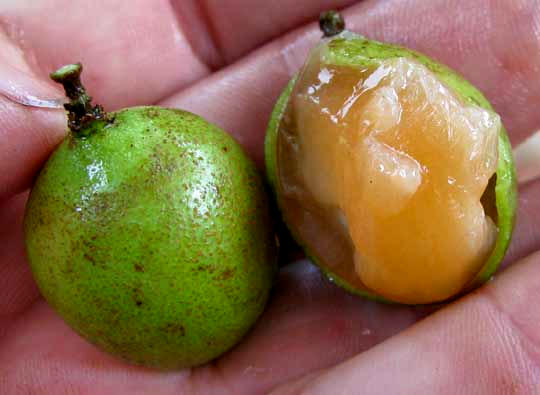 |
| J. Sarna: Extreme Pyramid Climber? |
I pick up some water, peanuts, and gummy bears at a local store and am on my way to the office in Tekal. I'm met by Manuel Chan, a Maya and director of the Reserve's tour company, along with Ismael, a Maya who grew up in Tekal and Jorge, a biologist from Mexico City who moved to the area a couple of years ago.
After talking a bit with the Manuel and the guides about the type of tour I'm interested in and my reasons for coming to Mexico, Manuel gives me the Company's Binder along with a copy of UNAM's Atlas of Traditional Mexican Plants, both of which he stresses are very important books but he wants me to have on the journey to learn from. After signing a waiver and the guestbook (lasted entry more than a month prior), Manuel tells me that Ox Watz means "three turns or trips" in Maya, meaning I will need to return to Ox Watz two more times in my life. With that promise, I hop into a truck with Ismael and Jorge and begin the journey to the Nature Reserve.
For the next hour, we drive on a small path through the monte (jungle), passing a few people on bicycles or scooters, along with several state police, who spend a few minutes asking us questions, and then send us on our way. The grass in the center of the path is as high as the truck, and several times Ismael stops while Jorge uses a machete to make the road wider. At one point, he jokes that he will need to give Jorge some lessons for cutting back trees. The key is fewer intentional cuts, that make the most sense. While driving, we discuss Maya traditions, other groups from the United States that have come to visit, politics (both Mexican and U.S.), and the future of Ox-Watz. There is a struggle between the desire to expand tourism efforts and the need to conserve the land and the species that live there. Improving the road means destruction of plants and animals. So, for now, visits to Ox-Watz are reserved for small groups, who are willing to spend the day hiking and driving long distances.
In the reserve, we begin with an Eco-Archaeology hike, which takes us to the top of a "conserved" (read: un-excavated, covered in dense vegetation) Pyramid. The path is steep, and the actual climbing of the pyramid is equally daunting. Ismael shows me a prism shaped rock to used build the pyramids and describes the great mathematical intellect required to build such a structure. That seems to be a repeated theme throughout the day: how much the Maya knew - about math, nature, plants, and living. On the way down the pyramid, a rock beneath me gives way and I fall, cutting my wrist. Walking away from the site, Ismael tells me to take out my bottle of water. "To wash my wrist?" I ask. "No, to close the energy circle. You've entered here and everything you touch has changed. It's just something we do to show respect." So, as instructed, I take a sip of water and then pour a sip on the ground, and then some on my bleeding wrist.
 |
| At the top of the Pyramid, several taller pyramids can be seen in the distance |
 |
| Guaya Fruit: Peeling them is the easiest part |
 |
| Hiking Back from the Pyramid |
After hiking back to the truck, we stop to eat some guaya fruit (a stone fruit which involves more sucking on the fruit then actual eating, as the fruit is so firmly held to the stone). Ismael is seated in front of a calabash tree, whose large green fruit looks like a big head, which according to Popol Vu legend, is exactly that, the head of the sacrificed father of the Hero Twins. (Good story.. check it out).
After a short break, it was time for another hike, this time to swim in a Cenote, where I would observe the incredible biodiversity of birds, plants, and insects living within Oxwatz. The cenote is guarded on one side by caves and filicidal trees, who swing their roots and vines across the cenote, suffocating nearby trees of the same species. The water of the cenote is cool, extremely refreshing after a long day of hiking and driving. Small fish nibble at my legs as I hang onto the edge, not wanting to venture out into the deep, bottomless swimming well.
On the way out of the reserve, a huge thunderstorm struck, adding to the adventure of the day. I think we made it out just in time! I went with Ismael and Jorge to the house of Ismael, where we ate Panuchos (Yucatec snack made with chicken, red onion, and lettuce) and drank Pozol, a drink made of corn chunks, coconut, water, ice and sugar. Ismael's father comes from a long line of hunters. He shared stories from hunting in the monte, like the day they netted 10 deer. A usual catch includes 1 deer and an assortment of small animals like squirrel, armadillo, rabbits, iguana, and such. It would be past 9pm when I arrived back from my Super Tour!
Oxwatz is not for everybody. Cenotes and Pyramids can stretch across the Yucatan, in all shapes and sizes. But for those looking for authentic adventure in the deep jungle, the experience is unforgetable. The dedication of the Oxwatz community to its vision and mission is truly noted, the connection between Maya culture and nature leaves a lasting impression on the tourist. Check out their site here, and set up a tour for next time you're visiting the Yucatan!
 |
| Looking Down at the Cenote of Ox-Watz |


No comments:
Post a Comment